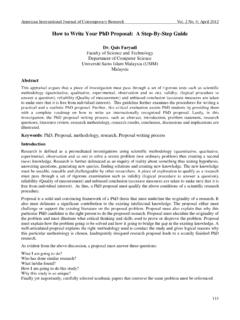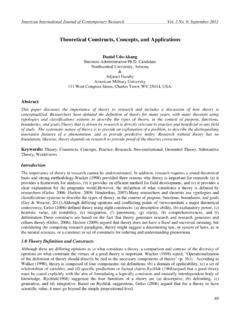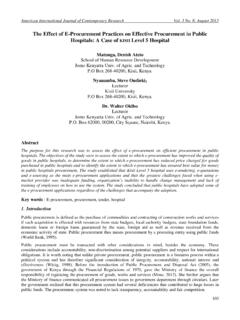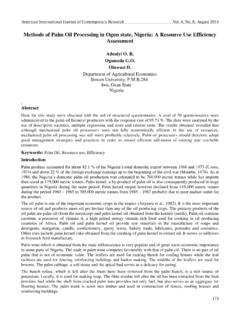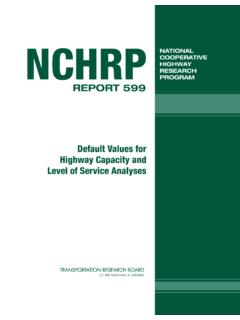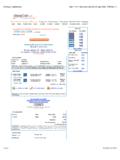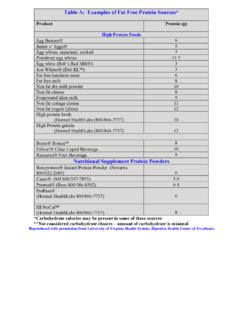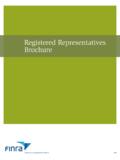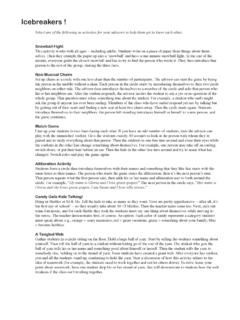Transcription of Causes and Control of Loan Default/Delinquency in ...
1 American International Journal of Contemporary Research Vol. 4, No. 12; December 2014 36 Causes and Control of Loan Default/Delinquency in microfinance institutions in Ghana Alex Addae-Korankye Central University College BOX DS 2310, Dansoman Accra, Ghana Abstract The study analysed the Causes and Control of loan delinquency / default in microfinance institutions in Ghana. Random sampling technique was used to select twenty-five microfinance institutions and two hundred and fifty clients for the study. Questionnaire and interview guide were used to collect data for the study. The study found the Causes of loan default to include; high interest rate, inadequate loan sizes, poor appraisal, lack of monitoring, and improper client selection. Measures to Control default were found to include training before and after disbursement, reasonable interest rate, monitoring of clients, and proper loan appraisal.
2 It was recommended among others that MFIs should have clear and effective credit policies and procedures and must be regularly reviewed. It was concluded that the government and hence Bank of Ghana should regularly monitor and supervise the MFIs so as to ensure safety of clients deposits and customers confidence. Keywords: microfinance institutions , Loan default , Loan delinquency , default rate, Micro, Small, and Medium Enterprises (MSMEs) Introduction International organisations are coming to the realisation that microfinance institutions ( MFIs )are veritable and effective channels to ensure programme implementation effectiveness, particularly in poverty alleviation projects and firsthand knowledge of the needs and interest of the poor (Okumadewa, 1998). According to Chossudovsky (1998), the World Bank Sustainable Banking with the Poor project (SBP) in mid-1996 estimated that there were more than 1,000 microfinance institutions in over 100 countries, each having a minimum of 1,000 members and with 3 years of experience.
3 microfinance Institution may be defined as any financial institution which offers not only small loans to microenterprises, SMEs, groups and individuals but also provides other financial services like savings, insurance, and investment advice including even training programmes to its clients. The issue of loan delinquency / default among banks and microfinance institutions has been discussed in many public lectures and fora as one of the reasons why commercial banks have not shown much interest in financing Micro, Small and Medium Enterprises (MSMEs). According to Balogun and Alimi (1990), loan default can be defined as the inability of a borrower to fulfil his or her loan obligation when due. High default rates in MSMEs lending should be of major concern to policy makers in developing countries, because of its unintended negative impacts on MSMEs financing.
4 microfinance institutions all over the world including Ghana are faced with the challenge of loan Default/Delinquency . The chance that a microfinance institution (MFI) may not receive its money back from borrowers (plus interest) is the most common and often the most serious vulnerability in a microfinance institution (Warue, 2012). According to her since most microloans are unsecured, delinquency / default can quickly spread from a handful of loans to a significant portion of the portfolio. This contagious effect is worsened by the fact that microfinance portfolios often have a high concentration in certain business sectors. Consequently, many clients may be exposed to the same external threats such as lack of demand for clients products, livestock disease outbreak, bad weather and many others. These factors create volatility in microloan portfolio quality, heightening importance of controlling credit risk.
5 In this regard, MFIs need a monitoring system that highlights repayment problems clearly and quickly, so that loan officers and their supervisors can focus on delinquency (repayment rate) before it gets out of hand. In lending services, a default is the failure to pay back a loan. Center for Promoting Ideas, USA 37 The microfinance institutions in Ghana including the private microfinance institutions , rural and community banks, and some Commercial banks are faced with loan delinquency / default , which may have long-term consequences if not addressed. Statement of the Problem The sustainability of microfinance institutions depends largely on their ability to collect their loans as efficiently and effectively as possible. In other words to be financially viable or sustainable, microfinance institutions must ensure high portfolio quality based on 100% repayment ,or at worst low delinquency / default , cost recovery and efficient lending.
6 However of late, there have been complains by the microfinance institutions regarding high rate of Default/Delinquency by their clients; which presupposes that most microfinance institutions are not achieving the internationally accepted standard portfolio at risk of 3%, which is a cause for concern because of its consequences on businesses, individuals, and the economy of Ghana at large. delinquency and hence default have started creeping deeply into the operations of microfinance institutions in Ghana hence the study into the Causes and Control of loan delinquency / default in microfinance institutions in Ghana. Objectives of the Study The study generally investigated the Causes and Control of loan default in microfinance institutions in Ghana. Specifically, the objectives of the study included the following; To examine the Causes of loan Default/Delinquency in microfinance institutions in Ghana.
7 To recommend measures to Control the Default/Delinquency in Ghana. Research Questions The study attempted to address the following questions: What are the Causes of loan delinquency / default in microfinance institutions in Ghana? What measures can be employed to Control loan delinquency / default ? Literature Review The Concepts of Loan delinquency and Loan default A loan is delinquent when a payment is late (CGAP, 1999). A delinquent loan becomes a defaulted loan when the chance of recovery becomes minimal. delinquency is measured because it indicates an increased risk of loss, warnings of operational problems, and may help to predict how much of the portfolio will eventually be lost because it never gets repaid. There are three broad types of delinquency indicators: collection rates which measures amounts actually paid against amounts that have fallen due; arrears rates measures overdue amounts against total loan amounts; and portfolio at risk rates which measures the outstanding balance of loans that are not being paid on time against the outstanding balance of total loans (CGAP, 1999).
8 default occurs when a debtor has not met his or her legal obligations according to the debt contract. For example a debtor has not made a scheduled payment, or has violated a loan covenant (condition) of the debt contract (Ameyaw-Amankwah, 2011). A default is the failure to pay back a loan. default may occur if the debtor is either unwilling or unable to pay their debt. A loan default occurs when the borrower does not make required payments or in some other way does not comply with the terms of a loan. (Murray, 2011). Moreover, Pearson and Greeff (2006) defined default as a risk threshold that describes the point in the borrower s repayment history where he or she missed at least three instalments within a 24 month period. This represents a point in time and indicator of behaviour, wherein there is a demonstrable increase in the risk that the borrower eventually will truly default , by ceasing all repayments.
9 The definition is consistent with international standards, and was necessary because consistent analysis required a common definition. This definition does not mean that the borrower had entirely stopped paying the loan and therefore been referred to collection or legal processes; or from an accounting perspective that the loan had been classified as bad or doubtful, or actually written-off. Loan default can be defined as the inability of a borrower to fulfil his or her loan obligation as at when due (Balogun and Alimi, 1990). American International Journal of Contemporary Research Vol. 4, No. 12; December 2014 38 Causes of Loan delinquency / default According to Ahmad, (1997), Causes of loan default include; lack of willingness to pay loans coupled with diversion of funds by borrowers, wilful negligence and improper appraisal by credit officers.
10 In addition, Hurt and Fesolvalyi (1998), cited by Kwakwa, (2009) found that, corporate loan default increases as real gross domestic product decline, and that the exchange rate depreciation directly affects the repayment ability of borrowers. Balogun and Alimi (1988) also identified the major Causes of loan default as loan shortages, delay in time of loan delivery, small farm size, high interest rate, age of farmers, poor supervision, non profitability of farm enterprises and undue government intervention with the operations of government sponsored credit programmes. Moreover, Akinwumi and Ajayi (1990) found out that farm size, family size, scale of operation, family living expenses and exposure to sound management techniques were some of the factors that can influence the repayment capacity of farmers. According to Olomola (1999), loan disbursement lag and high interest rate can significantly increase borrowing transaction cost and can also adversely affect repayment performance.
